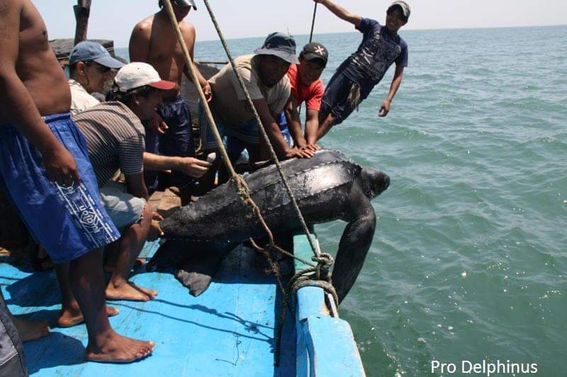
Mortality rates at sea have been identified as a critical aspect of sea turtle research by the Global Strategy for the Conservation of Sea Turtles. In Peru, together with the lack of education of fishing and coastal communities, the main threats to turtles are fisheries mortality (bycatch), and habitat degradation and pollution. In 2001, Pro Delphinus started a systematic assessment of turtle bycatch along the Peruvian coast. Over the past 10+ years, our Sea Turtle Program has led to great advances in our understanding of the threats turtles face from fisheries in Peru.
Loggerhead turtles
Our satellite tracking project was the first telemetry study of loggerhead turtles in the southeastern Pacific Ocean. The presence of loggerheads in this region was only recently verified. "Cabezona" (big head) or "Amarila" (yellow) are the local names for this species. The goal of this study, which successfully tracked 13 turtles, was to improve our understanding of loggerhead habitat use, migration and foraging patterns in the southeastern Pacific.
Click on the link below to see where these loggerheads traveled.
Leatherback turtles
Beginning in 2013, this ambitious project seeks to promote conservation of the critically endangered Pacific leatherback turtle. This is a regional initiative that combines fishery assessments and monitoring, leatherback turtle satellite tracking, and innovative efforts to reduce bycatch of leatherbacks and other sea turtles.
Click here to learn about our new project on humpback whale and leatherback turtle entanglements.
Hawksbill turtles
Our Hawksbill Satellite Tracking Project is the first telemetry study of the species in Peru. Hawksbills, including large numbers of juveniles, occur almost exclusively in the northern Peru, mainly in the regions of Piura and Tumbes. Using satellite telemetry, this study will examine hawksbill turtle habitat use to help determine priority areas for conservation and to better understand how these habitats overlap with fishing grounds.
Net lighting
Pro Delphinus is collaborating with NOAA researchers to test the use of LED lights placed on fishing nets in an attempt to reduce the bycatch of sea turtles (while not affecting the catch of target species). Tests of this technology in Baja, Mexico showed that using lights could substantially reduce the catch of sea turtles there. We are actively testing these LED lights in several net fisheries in northern Peru.
Sea turtle education program
The goal of our Educational Program is to reach out to the next generation of fishermen in the ports with the highest levels of sea turtle mortality and human consumption of turtles. Our aim is to provide these communities with information and the tools they need to make informed decisions about sea turtle conservation. Currently, Pro Delphinus continues to work in several ports along the Peru coast in collaboration with local fishing associations, schools, and government officials.
Current Funders





